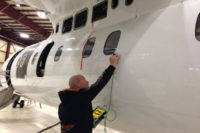Case Study
Gravity as a Measuring Tool
A flexible measuring solution for roller bearings.




Straightness, contours, roughness, taper angle—the measuring tasks applied to roller bearings are varied and complex. The Jenoptik Industrial Metrology division offers a high-precision solution for these tasks: the Hommel-Etamic nanoscan. A bearing producer is now using the machine to measure roughness and contours of roller bearings in a single run using a special fixture design
Roller bearings consist of two bearing rings and several rolling bodies (in the form of balls, cylinders, needles, barrels or cones) rolling on tracks between the inner and outer ring. Rolling friction occurs at the points of contact, which is why all of the individual components must be precisely matched with one another. It’s what makes quality control in production so vital.
The bearing industry offers a wide range of roller bearings that differ in their construction and particularly in their size, depending on their purpose and load direction. Managing complex measuring tasks is crucial for analyzing the components in detail—roughness parameters for the track, the outer and inner diameter, and the bore holes all need to be measured and recorded.
The straightness at the outside diameter, in the bore holes and at the sealing surfaces, is measured in order to determine the contours of the bearing, and the round angle of the inner and outer diameter is also measured. The accuracy with which the round angle (taper angle) is measured influences the load capacity and service life of a bearing; optimal surface roughness is, in turn, a prerequisite for a high running accuracy and low rolling friction.
With the Hommel-Etamic nanoscan, the Jenoptik Industrial Metrology division created a solution that takes combined measurements of the roughness and contours of roller bearings in single measuring run.
Depending on length of the probe arm, the machine can measure the most subtle surface roughness at a resolution of 0.6 to 1.2 nm. With a measuring stroke of between 24–48 mm, all measuring tasks for checking the surface can be completed with nanoscan.
Since individual bearing types and components differ considerably in their design, size and shape, bearing manufacturers expect maximum precision and flexibility from the range of applications offered by metrology equipment.
To make best use of this measuring flexibility, the part holding fixture had to be equally innovative.
A clamping device is generally used to secure both the inner and outer rings and the rolling bodies to be measured in the measuring machine in order to hold the parts in the precise position required. The probe arms can then move over the parts repeatedly with the utmost accuracy each time. However, several clamping devices are necessary when the measuring machine is working on different bearing parts and component sizes.
Making Use of Gravity
To eliminate the need for complex and inflexible machine changeovers the Jenoptik Industrial Metrology division cooperated with a manufacturer of high-performance bearing units to put an unusual metrology concept into practice.
A measuring station within the roller bearing production environment at Schaeffler Austria GmbH has been equipped with the Hommel-Etamic nanoscan solution. The device was assembled on a block of granite that features a surface incline of 20 degrees.
Markus Müller, Head of the Customer Projects department at the Jenoptik Industrial Metrology division, explained the advantages of the system, saying: “By using gravity and arranging the contact surface for the component at an angle, the part can be inserted, easily positioned with a single prism and firmly supported at the same time.”
Typical clamping devices can be completely omitted — only support devices and loading prisms are fitted in the loading position. This nanoscan is flexible enough to measure parts with diameters from 60–250 mm, regardless of their design. The measuring column on the nanoscan is positioned at the same angle as the contact surface in order to create a short measuring path to the part, in particular to the top section of the part.
User-Friendly Software
After manually loading the part in the measuring area and entering the parameters in the measuring program, a motorized X axis moves the part automatically into a predetermined measuring position. The machine conducts the measurement as a sampling inspection independently, allowing the operator to complete other tasks during the measuring process.
When developing the software, the Jenoptik engineers focused on ensuring that the software was as user-friendly as possible so that semiskilled workers can perform the measurements without specialized training. This is a particular advantage for shift work, especially during the night shift. For a new component, only the new parameters, such as the measuring characteristics, measuring positions and target limits, need to be entered into the database along with the permissible tolerances. The measuring conditions such as the measuring speed and range are also defined in advance.
Determining the Round Angle
Changing the stylus tips made from diamond, carbide or ruby spheres on the different probe arms is a quick and easy process thanks to the magnetic bracket. Probe arms featuring double stylus tips also move in both scanning directions as well as up and down in a single measuring run. Where previously several single measurements and evaluations were necessary, the nanoscan now conducts complex measuring sequences in one pass and evaluates them. The round angle so crucial for the precision of a bearing can also be determined at the same time via the top and bottom measurements.
By using gravity, the measuring machine’s unusual arrangement on an inclined surface fulfills Schaeffler Austria GmbH’s sophisticated requirements for flexible, fast, precise and cost-effective measuring solutions for use in the production of high performance roller bearings.
Looking for a reprint of this article?
From high-res PDFs to custom plaques, order your copy today!








